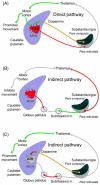International veterinary canine dyskinesia task force ECVN consensus statement: Terminology and classification
- PMID: 33769611
- PMCID: PMC8162615
- DOI: 10.1111/jvim.16108
International veterinary canine dyskinesia task force ECVN consensus statement: Terminology and classification
Abstract
Movement disorders are a heterogeneous group of clinical syndromes in humans and animals characterized by involuntary movements without changes in consciousness. Canine movement disorders broadly include tremors, peripheral nerve hyperexcitability disorders, paroxysmal dyskinesia, and dystonia. Of these, canine paroxysmal dyskinesias remain one of the more difficult to identify and characterize in dogs. Canine paroxysmal dyskinesias include an array of movement disorders in which there is a recurrent episode of abnormal, involuntary, movement. In this consensus statement, we recommend standard terminology for describing the various movement disorders with an emphasis on paroxysmal dyskinesia, as well as a preliminary classification and clinical approach to reporting cases. In the clinical approach to movement disorders, we recommend categorizing movements into hyperkinetic vs hypokinetic, paroxysmal vs persistent, exercise-induced vs not related to exercise, using a detailed description of movements using the recommended terminology presented here, differentiating movement disorders vs other differential diagnoses, and then finally, determining whether the paroxysmal dyskinesia is due to either inherited or acquired etiologies. This consensus statement represents a starting point for consistent reporting of clinical descriptions and terminology associated with canine movement disorders, with additional focus on paroxysmal dyskinesia. With consistent reporting and identification of additional genetic mutations responsible for these disorders, our understanding of the phenotype, genotype, and pathophysiology will continue to develop and inform further modification of these recommendations.
Keywords: dystonia; movement disorder; myoclonus; myokymia; myotonia; paroxysmal dyskinesia.
© 2021 The Authors. Journal of Veterinary Internal Medicine published by Wiley Periodicals LLC. on behalf of the American College of Veterinary Internal Medicine.
Conflict of interest statement
Authors declare no conflict of interest.
Figures


References
-
- Deuschl G, Bain P, Brin M. Consensus statement of the Movement Disorder Society on Tremor. Ad Hoc Scientific Committee. Mov Disord. 1998;13(suppl 3):2‐23. - PubMed
-
- de Lahunta A, Glass E. Nonolfactory rhinencephalon: limbic system. In: de Lahunta A, Glass E, eds. Veterinary Neuroanatomy and Clinical Neurology. 3rd ed. St. Louis, MO: W.B. Saunders; 2009:448‐453.
-
- Thomson C, Hahn C. Veterinary Neuroanatomy: A Clinical Approach. Edinburgh, UK: Saunders Elsevier; 2012.
-
- Obeso JA, Rodriguez‐Oroz MC, Rodriguez M, et al. The basal ganglia and disorders of movement: pathophysiological mechanisms. News Physiol Sci. 2002;17:51‐55. - PubMed
MeSH terms
LinkOut - more resources
Full Text Sources
Other Literature Sources

